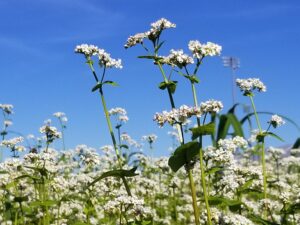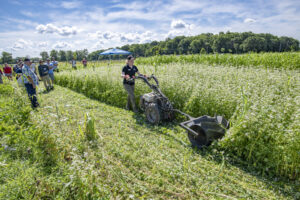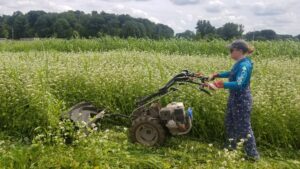Buckwheat (Fagopyrum esculentum) has been cultivated for thousands of years (Figure 1). Not at all related to wheat, buckwheat gets its common name from an old Dutch word that means “beech wheat” due to the seed’s resemblance to a beech nut. A member of the smartweed family, buckwheat is a cousin to familiar species like Pennsylvania smartweed, curly dock, and rhubarb.
Though buckwheat is not a traditional cereal grain species, its seeds can be processed into many of the same products as cereal grains, such as groats and flour. Humans began cultivating buckwheat thousands of years ago, which has led to its cultivation worldwide today. Common buckwheat foods include kasha, noodles, and pancakes. In the United States, about 27,000 acres of buckwheat are planted as a food crop every year, primarily in a few states in the northern US.
While buckwheat was initially cultivated as a food crop, this adaptable plant has recently grown popular as a cover crop species. Growing to 2-3 feet, buckwheat establishes rapidly and flowers prolifically. It tolerates soils with low fertility and poor structure. Its short life cycle allows it to bloom in as few as 21 days and reach maturity in as few as 70. Buckwheat is a warm-season species, so while it will not survive a hard frost, it thrives in warm to hot conditions. Due to its short life cycle and rapid establishment, buckwheat provides farmers with several ecosystem services when used as a cover crop species:
- Weed suppression (one colloquial name for buckwheat is “smother crop”)
- Pollinator reservoir
- Soil texture improvement
- Rapid residue decomposition
- Nutrient scavenging
There is some evidence to support buckwheat as a phosphorus-scavenging species. This process is thought to occur via buckwheat root exudates that liberate phosphorus from soil minerals.
Depending on the equipment available, you may plant/drill buckwheat or broadcast it. When drilled, buckwheat establishes well at 50-60lbs per acre at 1-1.5 in. deep. When broadcast, an increased seeding rate to nearly 100 lbs/acre and a pass with a gentle harrow aids establishment and improve the stand. Thinner stands adapt to gaps between plants by branching more, similar to soybeans. Plan to seed after the danger of frost has passed, preferably when soil temperatures are in the 50s.
On a vegetable farm, you might choose to plant buckwheat in a tight crop rotation window to suppress weeds before planting the next cash crop. Since it establishes rapidly and decomposes quickly, you can use it in much tighter planting windows compared to other cover crops. You might also use buckwheat to break the cycle of plant disease, particularly soil-borne disease. Since buckwheat is from a plant family, unlike most vegetable crops found on the farm, it generally does not host the same diseases (see Appendix 2 in Crop Rotation on Organic Farms by Mohler and Johnson). Finally, the pollen and nectar reserves provided by buckwheat attract many beneficial pollinators and predators – and if you’re a beekeeper, buckwheat allows you to add buckwheat honey to your market offerings.
Mow or crimp buckwheat to terminate it, usually 1-2 weeks after flowering begins. Residue decomposition accelerates with a tillage pass after mowing, but more nutrients might be tied up and unusable by your cash crop during that time.
The primary drawback of using buckwheat as a cover crop is its weedy behavior. It’s nearly impossible to prevent buckwheat from producing at least a tiny viable seed once it has flowered, so buckwheat will continue to live on the farm here and there as a volunteer. Luckily, it’s an easy-puller and easy to identify, so if you happen to find it comingling with your vegetable crops, it is easy to manage.
I crimped a mixed stand of sorghum-sudangrass and buckwheat at the Purdue Student Farm in July 2022 as a demonstration at the Small Farm Education Field Day (Figures 2 and 3). I used an Earth Tools BCS-compatible roller crimper, measuring 320 lbs and 30 in. wide, and made two passes with the unit. The buckwheat formed a beautiful mat, terminating nearly uniformly. Sorghum-sudangrass continued to grow, and a few buckwheat seeds germinated through the crimped buckwheat mulch. Farm staff left the field this way until just a few weeks ago when students and staff transplanted onions into this bed. Chris Adair, Student Farm Manager, noted he had seen relatively low weed pressure in this bed since the crimping operation and is optimistic about the bed’s performance moving forward.
This article is the first in a new series of articles for the Vegetable Crops Hotline called “Cover Crop Species Spotlight.” Make sure to look for more species spotlights in future editions of the VCH!


